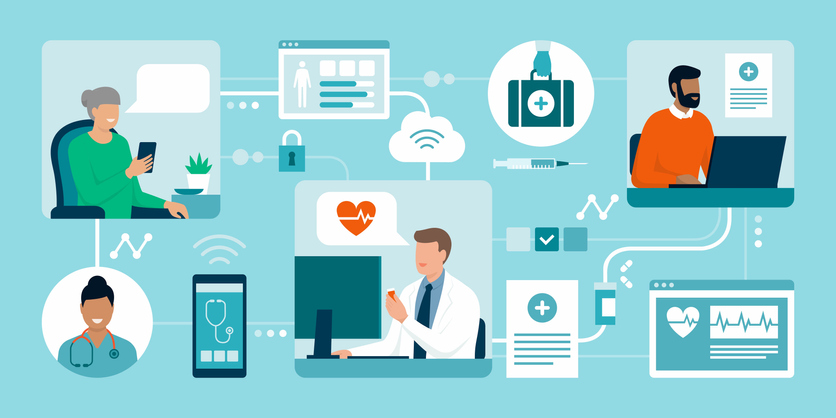
Ask any person to describe their experience with digital healthcare technology and they are likely to use adjectives such as complicated, frustrating and impersonal. The current tangle of electronic health systems, siloed point solutions and non-intuitive applications – none of which can communicate with others – has created a consumer experience that pales in comparison to the user-friendly modus operandi of other industries. Banking, transit and e-commerce have all prioritized the consumer with holistic platforms that deliver a seamless and truly positive experience.
An annual survey conducted by Cedar revealed that 49% of healthcare consumers wish that their digital healthcare experience was smoother and more closely emulated Netflix, Amazon or Uber. Where other industries provide personalized and engaging technology, healthcare falls short, but investing in the right patient engagement tools that tailor experiences will help to combat rising expectations.

With the Rise of AI, What IP Disputes in Healthcare Are Likely to Emerge?
Munck Wilson Mandala Partner Greg Howison shared his perspective on some of the legal ramifications around AI, IP, connected devices and the data they generate, in response to emailed questions.
These are the three changes health-tech needs to make to recreate Amazon, Uber or Venmo-like experiences in healthcare that will most accurately help to digitally replicate the humanized interactions that patients want:
Create an inclusive infrastructure
The digital ecosystem in healthcare reached the point of complexity we know today because of a lack of interoperability. With solutions working in a silo, patients are forced to manage multiple applications and web portals for each element of their care. A recent IQVIA Institute study found consumer app stores feature more than 350,000 health-related apps with an average of 250 new apps coming on the market daily.
To mitigate that complexity, digital platforms need an inclusive infrastructure with open APIs. Recent legislation, such as the Interoperability and Patient Access final rule, are helping to promote data sharing across platforms but the ecosystem is so crowded it will take years to achieve the level of interoperability consumers want. Implementing a more inclusive infrastructure will consolidate data and provide a single view of the patient, leading to a more positive digital experience.
Personalizing the experience
An inclusive infrastructure will unlock the power of data and enable “deep personalization.” For example, Amazon fosters engagement by tracking past orders and predicting what its users will want to order next. Spotify can recommend songs to listen to based on previously listened to playlists. Technology platforms need to gather information about the user to uniquely tailor the UX and UI, which will help to inform other aspects of the technology. How companies obtain that information and strategically utilize it will determine the quality of the user experience.
Healthcare organizations are improving their personalization methods by unlocking user data from wearables, EHR, claims, and patients health goals in combination to inform their presented unique user experiences. Utilizing bits of data from various areas of patients lives that are already being collected will enable the humanized experience through implementation rather than adding more steps to the process.
Technology is meant to act as an enabler, and although healthcare as a whole is behind, the industry is slowly implementing personalized strategies that improve engagement. The data silos that have historically restricted data sharing across platforms are starting to fall, and data from the traditional EHR can help to create a robust user persona. Open-architecture platforms that can leverage that EHR data will truly unlock the next generation of digital experiences. The largest EHR provider in the U.S., Epic, took a giant step toward a more interoperable healthcare ecosystem recently when it agreed to join the Trusted Exchange Framework and Common Agreement (TEFCA), an initiative designed by the Department of Health and Human Services (HHS) to establish a nation-wide data sharing network. Similar buy-in to the new legislation from players in the health-tech space will support the data-sharing we need to build a truly patient-centric healthcare ecosystem.
Building around consumer expectations
The aforementioned platforms like Amazon set the bar for consumer experience extremely high. Now, consumers expect that same level of personalized, high-quality experience in every digital interaction across industries.
A HealthMine Health Plan Intelligence Survey found 90% of health plan members have access to a member portal, but only 21% of them utilize the portal regularly. That lack of engagement likely stems from confusing navigation, general unhelpfulness or low incentivization. But pioneers in the consumer tech world have laid out a tried and true blueprint for engaging consumers and meeting – or exceeding – their expectations.
When Netflix evolved its model from a DVD mailing business to a direct-to-consumer streaming platform, it completely revolutionized the industry and was a masterful strategy in engaging its customers through multiple touchpoints – smartphones, smart TVs, and tablets. Healthcare technology can take a page from the Netflix playbook and earn its place on the homescreen of a customer’s smartphone. That requires consistent engagement between care providers and their patients, rather than on an episodic basis. After waiting for DVDs to arrive in the mail individually, the switch to streaming fundamentally changed how users engaged with Netflix. Similarly, if a consumer could access their healthcare information or even connect with a provider “on demand” it would dramatically change how they think about and interact with their care.
Through personalization, minding the consumer experience and open architecture, developers in healthcare technology can help the industry match the digital experiences that consumers have come to expect. By bringing the “Netflix experience” to healthcare and modernizing our ecosystem, we can make the patient experience simpler and more approachable. Humanizing touchpoints where patients once would have had an in-person encounter will assist in normalizing digital interactions. In turn, that approachability leads to increased engagement that can contribute to more positive patient outcomes.
Photo: elenabs, Getty Images














